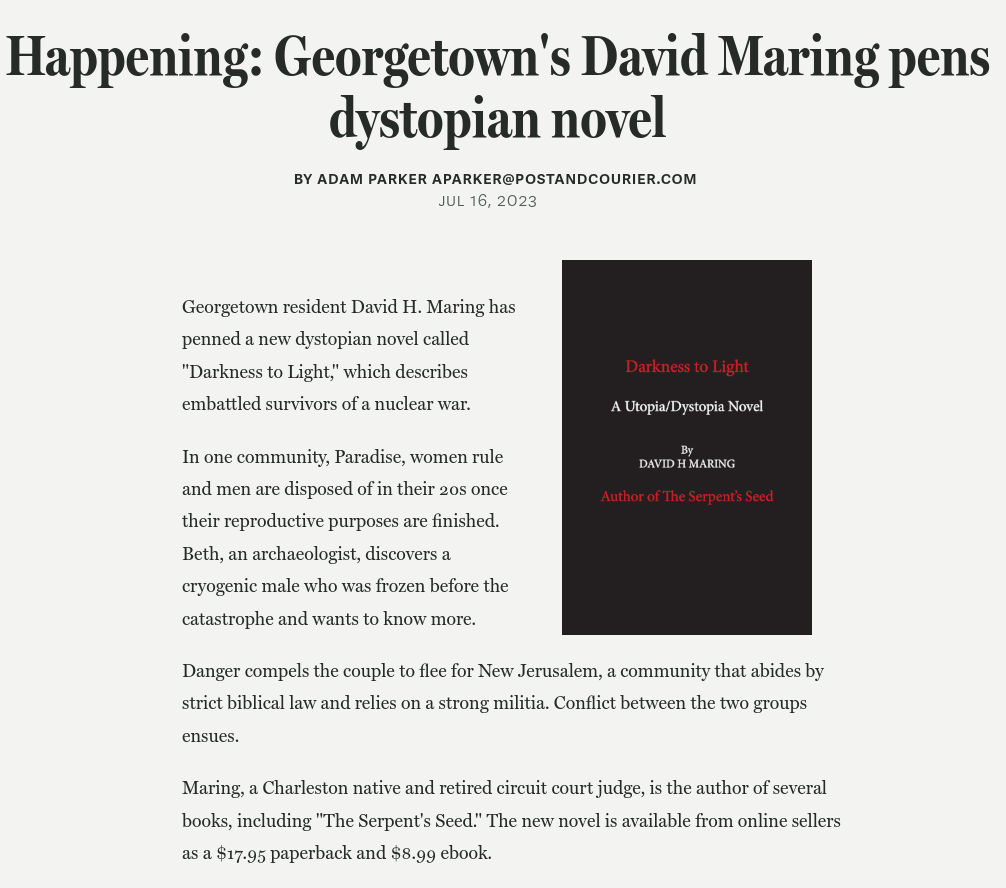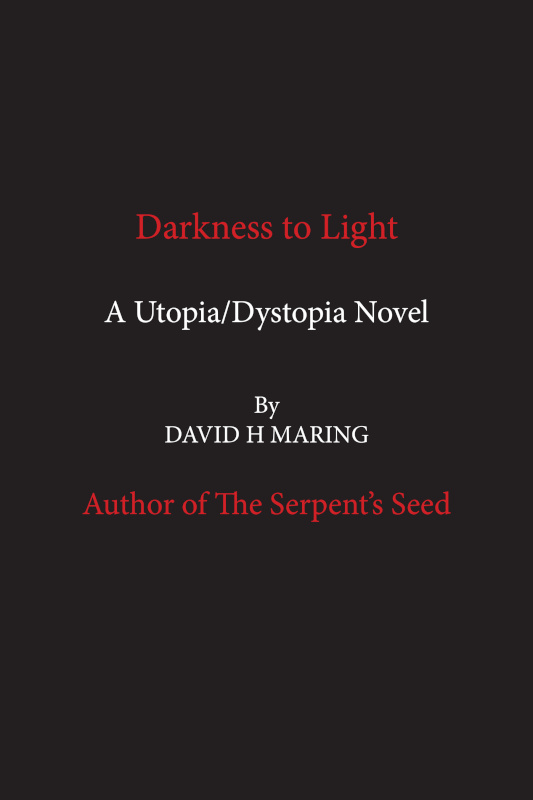Darkness to Light
Darkness to Light, a science fiction novel about a utopian/dystopian world that forms after a nuclear devastation, shows the dramatic reemergence of struggling communities through the experiences of a young archeologist, revived cryogenic characters, Messianic Jews, and an array of barbarians.
After this great catastrophe, the world enters a dark age when governments collapse as civilizations crumble. In the aftermath, survivors start the long and difficult journey back.
Paradise, a new nation state, exist on the eastern coast of the former United States. Women rule. The only males not killed at birth reside at the sperm farm. Providing this resource is their only function. This society is divided into Wos, who are female, and Donors, who are male. The Department of Fertilization is the only parent that a child knows. Outside Paradise other societies struggle to exist. Messianic Jews occupy the Northern Zone. Their capital is New Jerusalem. Barbarians are encroaching on both countries, which are in constant conflict with each other.
Generations after the great catastrophe a Wo archaeologist, Beth, discovers John in a capsule in the basement of a Decon Cryonics Center. After John is out of his frozen state, the two start an epic journey through a constantly changing world. It ends with humankind moving from a dark age toward the light.
Darkness to Light – A Review
by Donovan’s Literary
Readers of dystopian sci-fi have an ever-expanding list of books in the genre to enjoy, but David H.
Maring's Darkness to Light is perhaps the most appealing over many, offering a unique perspective and
social and cultural inspections of the long-term aftermath of a nuclear war that destroys civilization.
Where most dystopian sagas present a relatively simplistic view of barbarian versus civilized remnants of
survivors struggling for control, Maring chooses to view the revitalization and evolutionary process from
disparate sides. These include a young female Wo archaeologist who discovers the cryogenically frozen
John in a basement, revives him, and introduces him to this strange new world and Messianic Jews who
control a portion of the former U.S. and have built their own force in the Northern Zone, staving off
barbarians who would destroy their achievement.
These different perspectives and experiences enter into the bigger picture of social control, forbidden
actions, and efforts to accept the results of two rogue nations who introduced physical and mental
breakdown on a world-wide level.
Beth 20A lives After Great Catastrophe and works at uncovering remnants of the past and indicators of
light that she might use to dispel the dark age which evolved after the world-changing conflict ended.
The efforts of these new orders to control their environments and prevent the chaos that altered their
world forever are thought-provokingly presented:
"Beth was grateful that she was a wo. Her position was secured from birth by the selection process
created by the council, a body of eleven that ruled her world. Some groups created in the laboratory
after fertilization had lower intelligence. Scientific methods made sure their brain capacity was reduced
to the point where they could be conditioned to perform specific tasks assigned by the government and
never aspire to anything greater."
Raised both with the history of destructive choices and the possibility of becoming an unorthodox force
in an overly ordered, regimented world, Beth 20A has long learned to keep her insights to herself.
Neither mental illness nor aberration is tolerated in her world, and yet the creative force that stems
from diversity cannot be denied.
Beth 20A is a survivor who harbors secrets. And in a world of order and control, this is a dangerous habit
indeed, especially when her work uncovers new potential for revising humankind's future yet again.
Maring captures the perhaps-predictable clashes between these forces, but the real meat of his story
lies in the examinations of social and political interplays that evolve from a newly constructed world
struggling out of its self-imposed darkness. “…martial law was hardly noticeable in a society already
operating under a regimented lifestyle. In fact, it only brought more focus on the current leadership and
its inability to wield the reins of power effectively.”
From conspiracies and rescues to managing survivors without sparking rebellion, Maring interplays
characters and disparate interests with a strong eye to revealing and contrasting different forms of
darkness and enlightenment processes.
Readers interested in dystopian scenarios that incorporate but move beyond conflict into moral and
ethical realms of managing survival and growth opportunities will find plenty of discussion topics
throughout the social strata in Darkness to Light.
As moments are seized and changes instigated, the story becomes a thought-provoking series of insights
into many facets of civilization and survival tactics that will motivate libraries to include Darkness to
Light in their collections not only for its dystopian attractions, but for its opportunities to reflect on how
societies rise, fall, and achieve balance between control and creative evolution.
All these elements make for a gripping saga that is unpredictable, and hard to put down.
Darkness to Light
Review by Readers’ Favorite
In David H Maring’s Darkness to Light, a female-forward utopian society exists generations after a nuclear war decimated the world’s political landscape. The males allowed to live in Paradise, useful for little more than their ability to provide reproductive DNA, are segregated from the rest of the population and destroyed in their twenties when they no longer offer enough value to society. When Beth, an archaeologist, discovers a cryogenically frozen male from before the Great Catastrophe, she is naturally curious about him. After the situation in Paradise becomes dangerous for Beth, she and the man escape to New Jerusalem. In this nearby nation that relies on biblical morals and a heavy militia, they soon find themselves embroiled in an action-packed conflict between the two disparate states.
Utilizing a straightforward writing style, David H Maring delivers an intriguing story with constant movement that kept my attention throughout. The quick and steady flow of the narration left me wanting to learn more about the numerous characters that came and went as the story regularly shifted in unanticipated directions. I especially appreciated how well-conceived the dystopian world is, including references to pre-nuclear-war America, which effectively adds realism to the fictional future. Perhaps the most enthralling aspect of the plot is how pertinent to our time the book’s themes of gender stereotypes, governmental overreach, and personal and religious freedoms are.
Darkness to Light is a fast-paced dystopian novel that considers relevant social topics with a dose of science fiction and a flare of optimism.
Below from the “Post & Courier”, July 2023


